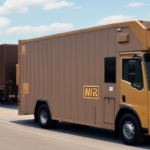Understanding UPS Shipping Rates and Size Limitations
If you are a business owner or someone who regularly sends packages and documents, navigating shipping services and rates can be challenging. UPS, one of the most well-known carriers, offers a range of shipping options that allow you to send packages both domestically and internationally efficiently. However, understanding their rates and size limitations can be overwhelming, especially if you don't ship frequently. In this comprehensive guide, we'll break down everything you need to know about UPS shipping rates, calculating costs, and size limitations to help you make informed decisions when shipping with UPS.
Breaking Down UPS Shipping Rates: A Comprehensive Guide
UPS offers a variety of shipping services, including ground, air, and international options. Shipping rates are determined based on several factors:
- Package Weight: Heavier packages generally cost more to ship.
- Destination: Rates vary depending on whether you're shipping domestically or internationally.
- Package Type: Different types of packages may incur different rates.
- Level of Service: Faster delivery options like Next Day Air are more expensive than ground services.
Additionally, UPS categorizes rates into:
- Retail Rates: Standard rates available to all customers.
- Commercial Rates: Discounted rates available for businesses.
- Daily Rates: Special rates for UPS account holders.
Depending on your shipping needs and membership level, rates can vary significantly.
An important factor to consider is delivery time. UPS offers guaranteed delivery times for certain services, such as Next Day Air and 2nd Day Air. If your package is not delivered on time, UPS may offer a refund for the shipping cost, though policies vary based on service level and delay reasons.
Another consideration is packaging requirements. UPS has specific guidelines regarding package size, weight, and materials. Non-compliance can result in additional fees or shipment refusal. Reviewing these guidelines before shipping ensures your package is accepted and arrives safely.
How to Calculate Your Shipping Costs with UPS
The most effective way to calculate your shipping costs is by using UPS's online shipping calculator. This tool allows you to input your package's destination, weight, dimensions, and desired service level. Comparing different service options can help you select the most cost-effective solution.
UPS offers discounts for frequent shippers and those utilizing their online tools. Signing up for a UPS account can provide access to these discounts, along with various packaging options like free boxes and envelopes, further helping to reduce shipping costs. Exploring all available options ensures you secure the best deal possible.
The Impact of Package Weight on Your UPS Shipping Rates
Package weight is a crucial factor impacting UPS shipping rates. Typically, heavier packages incur higher rates. For example:
- Packages under 10 lbs may be best suited for ground services, offering cost-effective rates.
- Heavier packages can utilize UPS's Less Than Truckload (LTL) freight services.
However, weight isn't the sole factor. Other elements like package dimensions, destination, and shipping speed also affect costs. Shipping to remote locations or opting for expedited services can increase rates.
To ensure you're getting the best possible rate, compare shipping rates across different carriers and services. UPS offers diverse shipping options, including ground, air, and international services, allowing you to choose the best fit for your needs and budget.
UPS Size Limitations: What You Need to Know Before Shipping
UPS imposes size limitations based on the selected service:
- Ground Service: Maximum combined length and girth of 108 inches.
- International Shipments: Maximum combined length and girth of 130 inches.
- Weight Limits:
- Ground services in the US: Up to 150 lbs per package.
- International shipments: Up to 500 lbs per package.
UPS also restricts certain items from being shipped, including hazardous materials (explosives, flammable liquids, radioactive materials) and illegal or prohibited items (drugs, counterfeit goods). Always check the UPS shipping restrictions before shipping to ensure compliance.
Tips for Choosing the Right UPS Shipping Service for Your Needs
When selecting your UPS shipping service, consider the following factors:
- Shipping Needs:
- If time-sensitive, opt for next-day or two-day services.
- For cost-effective shipping, ground services are suitable.
- If shipping fragile or sensitive goods, consider UPS’s specialty services.
- Destination:
- For international shipments, choose services that offer customs clearance and international tracking, such as UPS Worldwide Express, UPS Worldwide Expedited, and UPS Worldwide Saver.
- Package Size and Weight:
- For large or heavy items, consider UPS Freight’s LTL and FTL (Full Truckload) options.
- Utilize UPS’s range of packaging options, including boxes, envelopes, and tubes, to ensure safe and secure shipment.
How to Save Money on UPS Shipping Rates and Fees
Saving on UPS shipping fees without sacrificing quality is possible by:
- Using UPS’s Return Services: These services offer different levels depending on your needs.
- Signing Up for a UPS Account: Access discounted rates, rewards points, and other benefits.
- Utilizing Online Tools: Estimate shipping costs, track packages, and manage shipments using UPS’s online resources to avoid unnecessary fees.
- Being Aware of Additional Fees: Services like Saturday delivery or residential address delivery may incur extra charges. Understanding these fees helps you choose the most cost-effective options.
Understanding How UPS Handles Oversized Packages
For items exceeding UPS’s maximum size limits, you may need to use specialty services or LTL freight services. Oversized and bulky packages are more challenging to handle and typically incur higher shipping costs. Always check the dimensions and weight limits before selecting a UPS service to avoid unexpected oversize charges.
Navigating UPS Dimensional Weight: What it Means for Your Shipments
UPS calculates shipping rates based on Dimensional Weight, which considers the package's cubic size relative to its actual weight. This method reflects the space a package occupies during transit. Oversized packages may result in higher shipping charges due to the additional space required on delivery trucks. Accurate package measurements are essential for precise cost calculations.
Common Mistakes to Avoid When Shipping with UPS
Avoiding mistakes during the shipping process can save you time and money. Common errors include:
- Inaccurate Weight and Dimension Measurements: Ensure all measurements are precise.
- Choosing the Wrong Service Level: Select a service that matches your delivery timeframe and budget.
- Improper Labeling: Properly label your package to prevent delays and delivery issues.
Double-checking all details before shipping can help avoid these common pitfalls.
International Shipping with UPS: Understanding Rates and Requirements
When shipping internationally with UPS, additional taxes and customs fees apply. To ensure a smooth shipping experience:
- Review local regulations and requirements for the destination country.
- Ensure all documentation is correct and up-to-date to prevent significant delays and additional fees.
Proper preparation is key to successful international shipments with UPS.
How to Track Your UPS Shipments and Manage Delivery Expectations
Tracking your UPS shipments is straightforward with UPS providing a tracking number for each package. You can enter this number on the UPS website for real-time updates. Additionally, UPS My Choice allows you to manage delivery options, including selecting delivery times and locations. Tracking your shipment helps ensure a smooth delivery process.
The Benefits of Using UPS for Your Business Shipping Needs
UPS offers significant benefits for small business owners seeking fast and reliable shipping services, including:
- Flexible Shipping Options: Choose from a variety of services to meet different needs.
- Advanced Logistics Planning: Utilize UPS’s robust logistics network for efficient shipping.
- Tracking and Delivery Confirmation: Keep track of shipments and confirm delivery.
- Cost Savings: Streamline your shipping process and take advantage of different pricing levels based on usage.
Comparing UPS to Other Major Carriers: Which is Right for You?
When comparing UPS to other major carriers, consider each carrier's unique strengths and weaknesses:
- Network Reliability: UPS is known for its strong and reliable network.
- Cost-Effectiveness: Some carriers may offer more affordable rates or specialized services.
- Specialty Services: Depending on your needs, another carrier might provide services better suited to your shipments.
Carefully evaluate your shipping needs and utilize available online tools to select the right carrier for your business or personal needs.
Best Practices for Properly Packaging and Labeling Your UPS Shipments
Proper packaging and labeling are crucial for smooth delivery. Follow these best practices:
- Choose Durable Materials: Use sturdy boxes and packaging materials to protect your items.
- Use Proper Cushioning and Taping: Ensure contents are well-cushioned and securely taped.
- Use Legible Labels: Clearly label your package with the destination address and return information.
Adhering to these practices helps ensure your shipment arrives safely and promptly.
In conclusion, UPS offers a range of reliable and cost-effective shipping services. Understanding their shipping rates, size limitations, and service options benefits anyone who frequently ships packages and documents. Use accurate measurements, adhere to documentation requirements, and choose the right UPS service for your needs to save time and money while ensuring smooth, successful deliveries.




















